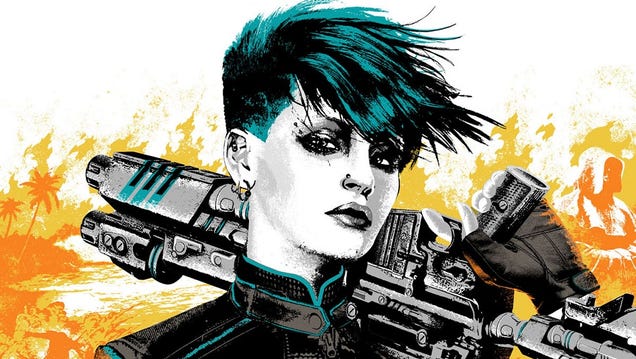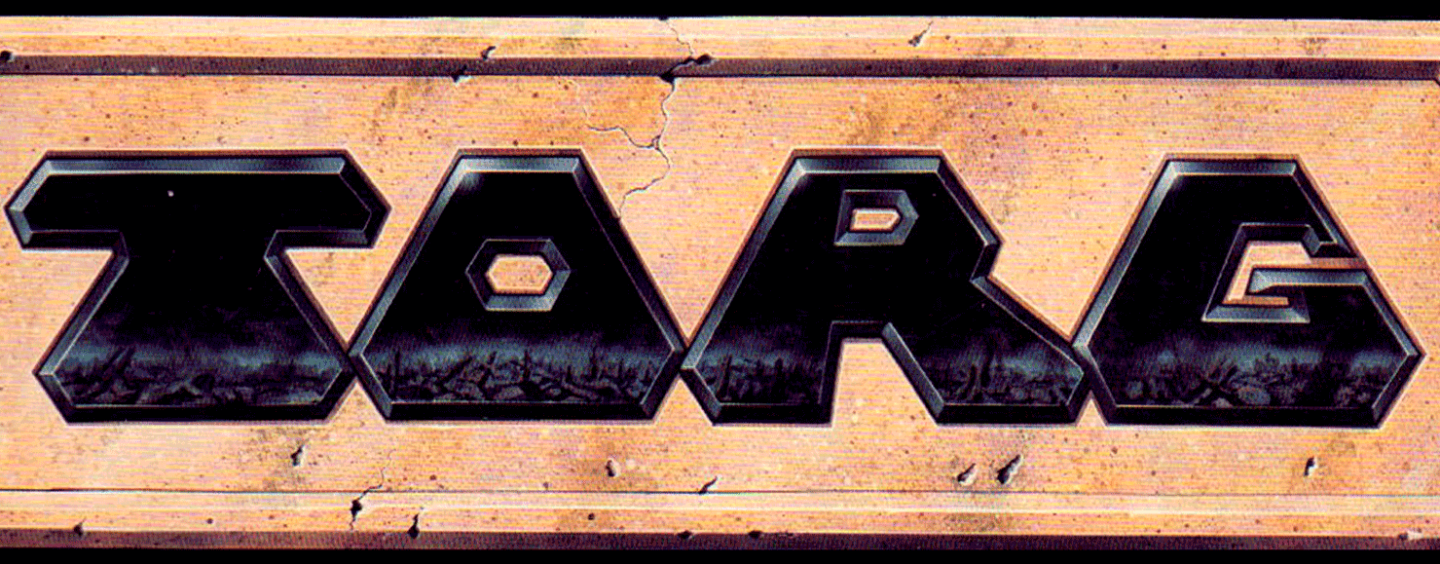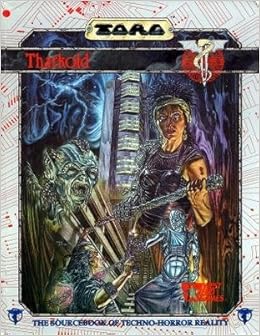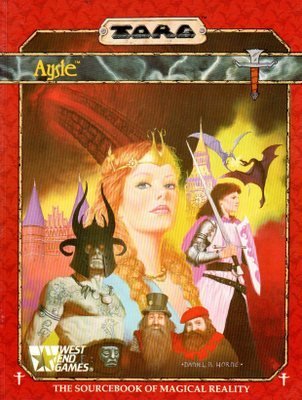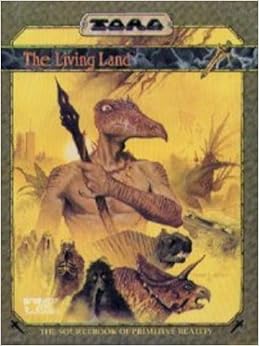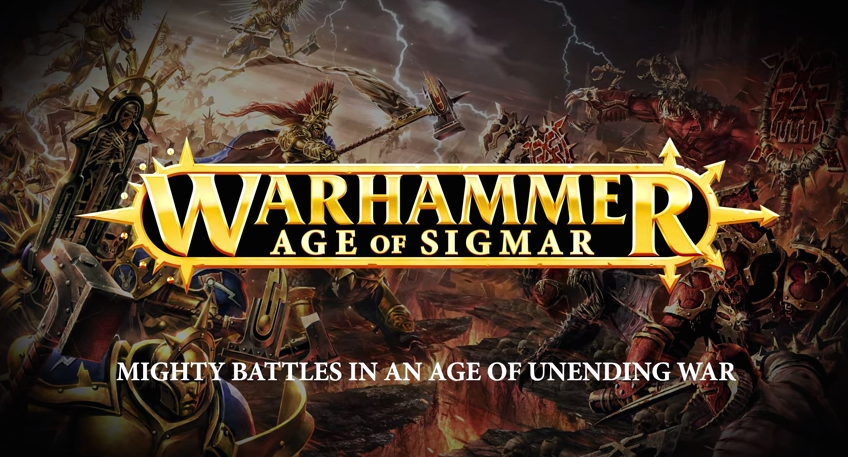Tuesday, 28 July 2015
Tabletop review: Rory's Story Cubes
Posted by
Scott Malthouse
Rory's Story Cubes
The Creativity Hub
Being a rabid tabletop gamer (as in, I really like them - I don't have rabies) I can never have enough dice or dice-like objects. To sate my need for the latter, it's Rory's Story Cubes to the rescue - a story crafting game for one or more players from the genius bods at The Creativity Hub.
The idea behind these simple little polyhedrons is that you and your friends roll them and craft a story using the pictograms on their faces. The pictures are simple and generic so you can easily interpret them how you like. For example, that friendly be could be just that, or it could represent and invading insectoid race hell-bent on eating our broadband. Depends on your frame of mind, I suppose.
Of course, that's the basic way to play with Story Cubes, but the website contains numerous ways to chuck around your picture bones and spin epic yarns. For the imaginative, it's easy to create new play styles - whether you're with a bunch of your fellow peeps, or you're alone on your sofa getting your mid-week slosh on.
There are several sets of Rory's Story Cubes, including Voyages and Actions - each of which add themed dice to the mix. There are also smaller sets including clues, intergalactic, enchanted, prehistoric and score - all of which can be mixed and matched with your other dice to create new stories.
Now, Story Cubes aren't going to be for everyone. There are no hard and fast rules, which I'm sure will put some people off, but for fans of storytelling and whimsy Rory's Story Cubes are a must buy. If you have kids, these are great. If you're a GM wanting to create a new adventure, these are super useful. If you're with a bunch of drunk friends, these are hilarious.
Monday, 27 July 2015
What is your favourite fantasy world?
Posted by
Scott Malthouse
Fantasy literature is bursting at the seams with incredible world-building, from the medieval trope definer that is Middle-Earth, to the satirical Discworld.
So which is your favourite fantasy world? Are you a Narnia fanatic, or maybe a Westeros fangirl? Let me know in the comments.
Sunday, 26 July 2015
Book review: Koko Takes a Holiday
Posted by
Scott Malthouse
Koko Takes a Holiday by Kieran Shea
Titan Books
Buy: UK/ US
Set 500 years in the future, Koko Takes a Holiday is nothing short of a acid-fuelled rampage through the warped synapses of author Kieran Shea, who pulls no punches in delivering a fantastic cyberpunk action romp.
The titular Koko Marstellar is a war veteran who has made quite the career change to becoming the owner of a brothel on The Sixty Islands - an entertainment haven for pleasure seekers looking to indulge in simulated violence and debauchery. Koko appears to have a good life of it - a retirement that consists of running a bar and getting her rocks off with one of the boywhores. But it all changes when the CPB (Custom Pleasure Bureau), led by her old military comrade Portia Delacompte, come a knockin' with orders to kill Koko. Deftly turning the invading security force into puddles of gore (don't for a second think that she's rusty when it comes to killing), Koko finds herself on the run from a collection of assassins hired to make sure she doesn't make it to the next day.
She manages to get herself on board the barges of the Second Free Zone, sources weapons and sets about trying to keep her head down while the assassins try to find her. While there, her path crosses with Flynn, a security officer who has been diagnosed with 'depressus', a syndrome that leads quite a high percentage of people on board to kill themselves. Oh, but they don't just off themselves - the ships actually host a televised event called the Embrace where large groups of sufferers take a happy pill before plummeting en masse to the Earth below. Flynn finds himself tangled with Koko's dilemma and aids her along the way.
The main hook of the story is that due to having her memory wiped through multiple rudimentary procedures, Portia has no idea why she gave the order to kill Koko - after all, they fought together and considered her a friend. It's a great story that unravels towards the end where the reader finally discovers why Portia ordered the hit and, well, it's pretty hard-reading.
Shea manages to create a uniquely bizarre universe in a relatively short space of time - one that's completely exaggerated and satirical of the media and human nature. Every now and again the book is punctuated with scripts from fictional advertisements in the Koko universe. While novel, the gimmick doesn't really work well and I found it pretty jarring.
The narrative floats between perspectives at breakneck pace, suiting the story well, weaving in snappy dialogue and colourful characters to create a book that feels like a punch to the gut - in a good way.
Koko Takes a Holiday is well worth your time, especially if you like your cyberpunk with more action than complex techno-babble. This is a universe that I can't wait to revisit in the sequel - Koko The Mighty, which is out soon.
Verdict: Read it
Saturday, 25 July 2015
A storm is coming: a TORG primer
Posted by
Scott Malthouse
Roleplaying fans on social media and around the RPG blogosphere have been buzzing about the return of the beloved TORG franchise with TORG: Eternity, published by German company Ulisses Spiele.
No doubt this will be huge news at Gen Con, which kicks off July 30 and runs through to August 2, where we are expected to hear more details about the resurrected game, originally published by West End Games in 1990.
It's telling how much love there is for TORG when you see fan messages like these:
Torg Eternity Coming in 2016 http://t.co/bZU8tg3GfV So excited for this, I love the setting and look forward to a new edition.
— Roberto Micheri (@Sunglar) July 21, 2015
Fantastic news for tabletop RPG players... TORG returns. http://t.co/1Ml8TZSeRB
— Doc Wilson (@DocDraconis) July 21, 2015
Wow. TORG is coming back! My favorite RPG of all time: http://t.co/l0bcpUVzSs
— James Dawsey (@VigilancePress) July 21, 2015
But for the uninitiated it may be difficult to see what's so special about the announcement of TORG: Eternity and why so many people are excited about it.
TORG was a relatively obscure game. Its name stems from the working title the designers had: 'The Other Roleplaying Game', and unable to come up with anything better, they went with it. But TORG made a name for itself by being a different beast from its predecessors, both mechanically and in its source material.
The Story
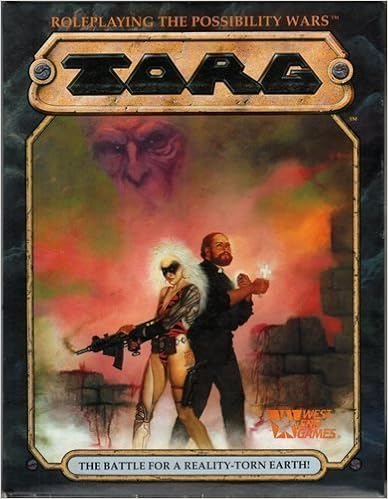 Set in the 'near now', TORG's story revolves around an Earth that has been invaded by reality-altering High Lords, who have changed parts of the planet as a reflection of their own worlds. The players take on the roles of the amazingly named Storm Knights - rebels from Earth and invading dimensions - to stand against the High Lords.
Set in the 'near now', TORG's story revolves around an Earth that has been invaded by reality-altering High Lords, who have changed parts of the planet as a reflection of their own worlds. The players take on the roles of the amazingly named Storm Knights - rebels from Earth and invading dimensions - to stand against the High Lords.
Each High Lord had in their possession an item known as a Darkness Device, intelligent machines created by an entity known as The Nameless One. These devices could rip holes in dimensions, creating portals to other worlds - hence how they could run rampant on Earth. They were also able to duplicate their own 'cosm' into the one they had just invaded, all the while reducing the target cosm's 'possibility energy' - an energy that helps heroes pull off amazing feats. The High Lords also gained the horrendously unfair advantage of being able to remake the physics of their target, making their invading forces much stronger that the defending one.
One of the High Lords, known as the Gaunt Man, stumbled across Earth and found that the planet possessed a crazy amount of possibility energy. While he knew he wanted to invade Earth, he knew that, due to sheer amount of possibility energy, there would be an energy backlash if he were to open a portal and he would never be able to invade. Instead, he joined forces with other High Lords who simultaneously opened portals, spreading the energy backlash through multiple channels rather than just the one. This meant that they were able to storm Earth and alter different locations in accordance with their own cosms. So on Earth, you have dinosaurs attacking the United States, France turns back to the Middle Ages, and Egypt is attacked by futuristic soldiers.
The Gameplay
TORG was a cinematic game, reflected by the mechanics. Characters had eight attributes that exponentially increased as their experience progressed. To perform actions, a d20 was rolled and compared to a difficulty number. If the player rolled a 10 or 20 then they would roll again, simulating the super awesome things that cinematic, larger-than-life heroes can do. The total would also be compared to a table, which would offer a bonus depending on the number rolled. There were also degrees of success that were determined by how far above the target you managed to roll.
Players had possibility points they could spend on adding to a die total, cancelling damage, improve an ability or even warp reality. They would save up possibility points to learn new skills and 'level up' at the end of a game.
In addition, a Drama Deck was used to shake things up during combat. The players would have their own cards and so would the GM. These could be played to add something new to the game, such as sub-plots, ability-enhancement and more possibility points. Using cards in conjunction with points allowed players to pull off amazing feats.
Combat was simple enough, but did carry one strange flaw that will hopefully be rectified in the new edition. Basically, the attacker had a to-hit total, which was compared to the target's defence total. If they hit, their damage value was compared to the target's toughness to see how much damage they did. Seems fine, right?
Well, this is where the so-called 'Glass Ninja Syndrome' comes into play. In TORG, the to-hit and damage rolls were the same rolls. This meant that, while a target with a high dexterity would rarely be hit, when they were they received a whopping amount of damage. Hence, glass ninja.
The Sourcebooks
West End Games released a range of sourcebooks over the years to expand TORG's setting. Some of these sourcebooks became a requirement for players who wanted to do certain things with their characters, like create their own magic spells, learn martial arts or gain some cool cyberpunk gear.
There was noticeable power creep as a result of subsequent sourcebooks, turning players into alien gun-toting cybermancers, which, while cool, did warp the game a tad.
The Future
TORG: Eternity is set to be released in 2016, headed up by Shane Hensley, creator of Savage Worlds and Deadlands. It's difficult to say whether there will be a complete rules overhaul, but it would make sense to streamline the bumpy mechanics and power creep while maintaining the great cinematic feel of the original.
Stay tuned for more information about the game coming out of Gen Con at the end of the month.
Follow me on Twitter @trollishdelver
Wednesday, 22 July 2015
Book review: The Empress Game
Posted by
Scott Malthouse
The Empress Game by Rhonda Mason
Titan Books
Buy UK/US
Prepare to make Kayla Reunimon your next favourite warrior princess. The Empress Game by debut author Rhonda Mason is a blistering space opera chock full of political intrigue, back-stabbing conspiracy and good old-fashioned ass-kicking.
Kayla has been in hiding for five years, living as a 'pit whore', a type of planetary gladiator, while protecting her brother Corinth from the people who want them both dead. You see, Kayla is a princess from the planet Oroch located in the wonderfully named Wyrd Space. When the Sakien Empire's International Diplomatic Corps (IDC) pulled off a coup that destroyed her people and family, Kayla and Corinth escaped and went into hiding. In the years that passed, the warrior princess scratched a living from becoming a different kind of ruler - the ruler of the blood pit - adored by the fans she despised and forced to put on a show by her seedy manager under the moniker Shadow Panthe.
Her fighting prowess piques the interest of IDC agent Malkor, who deems her worthy to fight in the Empress Game - an event where princesses from across worlds come to battle one another in a bid to gain a seat at the Council of Seven - the rulers of the Sakien empire who have the casting vote over the most major political decisions of the empire. Kayla is brought on to take the place of princess Isonde to enable Isonde and her supporters to gain the seat on the council and cease the occupation of Oroch. All she has to do is beat hundreds of vicious combatants to get to the throne.
There's a lot at stake in The Empress Game. Not only is Kayla fighting for the freedom of her people under the guise of another princess, but one plot thread involved a manufactured nano-virus that is spreading between worlds, turning people into nasty lumps of black goop - a virus that the Orochians may have the antidote to. It's the continued stake-upping that makes The Empress Game such a thrilling read, as well as its fantastic characters and proficient world-building. While this is the first book of what will be a trilogy, Mason has deftly created a universe that feels complete and complex that feels like it's been built over a series of books, rather than during its debut.
I'm a huge fan of strong, independent heroines who don't take guff from anyone, and Kayla is definitely that. Add to that a healthy dose of political thriller, a love story and a fantastic supporting cast and you have an incredibly effective sci-fi epic. I can't think of a reason why you shouldn't read this book. Just do it!
Verdict: Read it
Disclaimer: This book was provided to me by Titan Books
Tuesday, 21 July 2015
Spotlight on: Reaper Miniatures
Posted by
Scott Malthouse
It's telling that the latest Kickstarter from miniatures vanguard Reaper has raised over $1.5m from a $30,000 goal. It's also telling that the Bones 3 project is the fourth Kickstarter that the company has done and it is still gaining lucrative amounts of cash. So why the hell is Reaper so popular?
The Texas-based company was founded in 1992 in a garage in Fort Worth, initially selling a line of Second World War aircraft called Distinguished Flying Collectibles, and a range of fantasy-themed jewellery called Renaissance Dreams. Soon, in 1993, they created the Dungeon Dweller line of 25mm fantasy models that formed the early backbone of their fantasy minis offering - one that would eventually lead Reaper to become one of the most beloved companies in miniature manufacturing.
In 1996, Reaper would go on to launch the Dark Heaven line, becoming the best selling fantasy minis line in the world and becoming the company's core offering, with the current Dark Heaven Legends line passing a massive 3000 serial numbers.
New lines sprung up over the years, including Reaper's wildly popular Warlord skirmish game, Combat Assault Vehicle, Chronoscope, Legendary Encounters and more. It's easy to see why fans are so in love with Reaper - the sculpts are extraordinarily detailed (a far cry from the Dungeon Dwellers of 20 years ago) and just a joy to behold.
It's not just in-house IPs Reaper produces. Now, the manufacturer has its mitts on fan-favourite RPG licenses like Pathfinder, Savage Worlds and Numenera
Now, understand that Reaper makes premium minis, meaning that your wallet isn't going to have an easy time of it if you want to splurge on some some sets or blister packs. However, you're paying for quality and you're not going to find many more manufacturers making products like this.
By the way, I've not been paid or anything to write this post. I doubt Reaper will even see it - but I think it's important to support the companies who help make the roleplaying hobby that much more special, which is why I started this spotlight series.
Monday, 20 July 2015
Tabletop review: Coup
Posted by
Scott Malthouse
Since Game of Thrones is all the rage, political weaselings have become the thing that all the kids are into at the moment. Coup is just the game to settle that itch that we all have from time-to-time to solidly dick our friends over...all in good fun, of course.
Set in the same universe as Indie Boards and Cards' smash The Resistance, Coup is a sci-fi themed card game where the ability to cleverly bluff can pay off greatly. Each player is dealt two cards face down. Each card represents a certain character, such as a duke, captain or assassin, who have their own special abilities that aid with the aforementioned dicking over. All cards are placed face down in front of the players throughout the duration of the game and the aim is to be the last one with a card left on the table. There are different ways that a player can lose their cards. They can be assassinated by an opposing assassin, called out on their bluff, wrongly calling someone else's bluff or have a coup committed against them.
As play continues, players will get money from the treasury, which can be spent on pulling off a Coup or assassinations. Players can take one coin by default per turn, or take a risk and announce they are taking foreign aid, which will allow them to take two coins, but be at the risk of being blocked by a duke. But, what if the other player who wants to block you doesn't even have a duke? This is the core of what makes Coup such a fantastic little game - you will always be skeptical and constantly second guessing your opponent. It's a beautiful slice of paranoia that keeps the game fresh every time you play.
Coup is the perfect palette cleanser between larger games, taking around five to ten minutes per game, but it's easy to get carried away and string together 10 or 20 games without growing bored. If you love fast and fiendish games, you should definitely check out Coup.
Verdict: Play it
Sunday, 19 July 2015
What you need to know about Warhammer: Age of Sigmar
Posted by
Scott Malthouse
Arguably the most popular tabletop miniatures game, Warhammer Fantasy Battles, has just had a radical makeover with the advent of Age of Sigmar, opening up the game to a wider audience. The previous editions had grown stale and with the market slumping it was high time that Games Workshop did something drastic to keep itself relevant. The brand's solution was to overhaul Warhammer Fantasy by cutting the fat, revamping the lore and offering a game that is more streamlined and accessible to new players.
Down with the old lore
Over the years the Warhammer world had become a bloated behemoth that all but the veterans could decipher. With eight editions under its belt, roleplaying games, board games and hundreds of novels, Games Workshop had nurtured a living, breathing world with its own intricate history and characters. Age of Sigmar has expunged the backstory in a not-too dissimilar way that Disney cut the fat with the Star Wars expanded universe, and replaced it with something more unique and less grim Tolkien.
The new story revolves around Sigmar, who, after the events of The End Times, found himself hurtling through space on the dead husk of the old world. He was found by the great drake Dracothion, who helped him form the Mortal Realms with the use of Realmgates, creating a utopia for all mortal beings. However, corruption crept in through Chaos and the Age of Chaos began. Sigmar retreated into the Celestial Realm and formed an army of the greatest mortal warriors and named them the Stormcast Eternals. The starter set deals with these so-called Realmgate wars, as Sigmar's Stormhosts battle the forces of Chaos. Stormcast Eternals are basically fantasy Space Marines and form part of the starter set, along with Chaos.
Races like Skaven have also returned to the fore, along with similar races who have had slight name changes. Elves have become Aelves, while Orcs are now Orroks, Goblins and Grots and Ogres are Ogors - presumably so they can all be trademarked.
The new mechanics
If the fresh new fiction wasn't enough, the game itself has been almost completely altered. Miniatures are now on round bases, akin to Warhammer 40K, with an emphasis now on small-scale skirmish games rather than sprawling battles. That's not to say this can't be done - Games Workshop insists that you can still use all your old figures, just don't expect army building to be the same. Gone is the points-buy system, replaced with advantages to diminished forces to keep things balanced. This means that getting minis to the table will be a lot quicker, but whether it works just as well remains to be seen.
Each unit now has four stats and combat rules have been somewhat streamlined, although the familiar 'to hit', 'to wound' and saving rolls are still present. Instead of comparing stats against the enemy on a chart to find out your target roll, you instead roll against your own weapon stats. For instance, to hit you have to roll equal to or above your weapon's To Hit stat. This works exactly the same with with wounds. This presents an easier rules-set for new players, but I'd imagine that some veterans might not take too kindly to such a revamp.
What's more interesting is that the rules have been cut down so much that they now fit on a four-page document, which is freely available from the Games Workshop site as well as included in the starter set. They have also released a free set of compendiums called Warscrolls that help players with existing armies use them for Age of Sigmar.
The price of war
If you want to dive into the game, then you'll need the Age of Sigmar starter set which is going to set you back £75, which is a little steep but the miniatures do look absolutely fantastic. For your hard earned cash, you get the following?
One Lord-Celestant
One Lord-Relictor
Three Retributors
Two units of five Liberators
Three Prosecutors
One Mighty Lord of Khorne
One Bloodsecrator
One Bloodstoker
One Khorgorath
Five Blood Warriors
Two units of ten Bloodreavers
A ninety-six page Warhammer Age of Sigmar
A four-page rules set (this is everything you need to know to begin playing);
A pack of twelve dice;
Two range rulers;
Enough transfers to apply to all of the included Stormcast Eternals.
Not a shabby package, to be fair.
Saturday, 18 July 2015
Book review: Throne of Glass
Posted by
Scott Malthouse
Throne of Glass by Sarah J. Maas
Bloomsbury Publishing
Buy it: UK, US
So, I'm pretty late to the game with this YA series from Sarah J. Maas, who has so far released three novels in the series along with a collection of short stories, with a new book called Queen of Shadows on the way. It's also garnered a pretty healthy fan base since Throne of Glass was released back in 2012, with 192,000 copies of the series sold since its debut.
Throne of Glass was Maas' first novel, reportedly conceived of when she was 16 years-old, and it does somewhat smack of new writer. This isn't necessarily a criticism, but an observation that you're getting a book that has some serious potential but the author hasn't quite worked everything out yet.
Erilea is the fantasy land in which the action of Throne of Glass takes place, following the story of Celaena Sardothian, an 18 year-old assassin who we first meet in a prison camp based in the salt mines of Adarlan, one of the kingdoms in Erilea. Celaena is given the chance of freedom when the king of Adarlan requests that she takes part in a tournament of sorts to become his own personal assassin for four years, after which she would be allowed to go on her merry way. Of course, the young lady accepts, and so begins an almost Hunger Games-esque fantasy yarn where potential candidates for the position have to go through a series of challenges, from archery to testing poisons - culminating in a tournament-like melee.
Along the way we meet the Chaol, the king's gruff-but-soft guard captain, and Dorian, the boyish hormone-addled prince, both of whom form a love triangle for Celaena. Yes, this assassin does go goo-goo for the lads and does love a nice pretty dress, which I can't decide whether it's empowering or not. Perhaps that's not for me to judge, but I do quite like her character. She's precocious, intelligent and a bit of a bad-ass. The supporting characters are also well-realised, but perhaps could have done with a bit more polish.
Throne of Glass does suffer from pacing issues and some of the challenges could have stood to be a little more exciting and gruelling to really draw the reader in, but as a debut book this is a solid read. I can imagine that Maas' talents become more well-defined as the series progresses, because Throne of Glass shows a lot of promise for the young writer.
Verdict: Read it
Monday, 13 July 2015
Check out this badass Canary Overdrive fanart
Posted by
Scott Malthouse
Sunday, 12 July 2015
Deluxe Tunnels & Trolls - first impressions
Posted by
Scott Malthouse
To say that it's been a long time coming is an understatement. Deluxe Tunnels & Trolls funded on February 6th 2013 and since then fans have been waiting with bated breath to get their hands on the latest edition of one of the oldest and most beloved roleplaying games ever. After a couple of setbacks the team behind the game have finally released Deluxe T&T in PDF form, with the promise of a physical copy to follow shortly. So, was it worth the wait?
Yes, yes it was.
I'm not going to fully review the rules just yet, but I wanted to give my first impressions of the book. In a word, it's impressive. In two words, it's bloody impressive.
Previous editions of T&T have had somewhat lean rulebooks. Not anymore. The new edition is just over 360 pages and packed to the brim with new stuff. This looks like the most complete edition so far, with setting details, adventures, maps and more little extras that really reinforce why this is called Deluxe.
Cover Art
A Liz Danforth special and, in my opinion, one of her best pieces she's done for T&T. It's definitely in-keeping with previous covers, showing adventurers fighting monsters, but this is by far the most effective cover I've seen from the series.
Character Creation
The first thing anyone wants to look at in a new game edition is how much the rules have changed. Thankfully, the elegant core rules that T&T has almost always had is still there. Your characters have eight attributes and combat adds, just like they always have. As in 7.x, there are no missile adds in order to stop people just pumping their dice into dexterity and strength, which is a relief. The biggest change is that if you roll under nine when creating your character, you no longer get a minus to your adds. This means that smaller, more fragile kindred like fairies aren't going to begin with -4 combat adds while the brawny dwarf warrior starts with 17.
Similarly, the three basic character types are still there: warrior, rogue and wizard, although there have been tweaks to their abilities. Warriors get a weapon bonus to any melee weapon they are using, granting them an extra d6 per level. If you're level 1 and using a 3d6 sword, then you're going to be rolling 4d6. If you were level 5 then you would be rolling a whopping 8d6. That's crazy powerful - so powerful that it's acknowledged that you can change to a standard +2 per level instead if you feel like it's game-breaking. Warriors also have the standard armour bonus skill that doubles any armour they are wearing. This has always been a bit much for me, but in the latest rules armour can actually break, so it's a little less crazy.
Wizards are essentially entirely the same as in the previous edition. They can cast spells, use a focus to make those spells cheaper and they can only use weapons of 2d6 unless they want to not be able to include their combat adds.
Rogues are also very similar. They are still lite magic-users who can choose to be a rogue-wizard or rogue-warrior at level 7. They have the Talented skill that allows them to select another talent on character creation - different from the previous edition where they received the 'roguery' talent.
There are also Specialists, like in 7.x, who work in the same way - roll natural triples on a prime attribute in character creation and you have the option to become a specialist. Specialists are detailed later on in the Elaborations section.
Now let's move onto kindred, which again, is pretty similar but has some key differences. The Good Kindred is now the catch-all term for Common Kindred, which includes Humans, Dwarves, Elves, Fairies, Leprechauns and Hobbs. There is more information about each kindred than in previous editions, giving you a better overview of what they're all about. Dwarves even have two sub-races: Gristlegrim and Midgardian, each with their own strengths and weaknesses.
Humans were always pretty boring in T&T as they only get a multiplier of 1 for each of their skills, making them balanced, but kind of weak. Now they have a rule where they can re-roll a failed saving roll (except if they fumble), which at least gives them some kind of advantage.
Character leveling is the same as in the previous edition, where levels are tied directly to attributes. If one of your primary attributes is 20, then you're level 2 (divide by 10 and round down).
Talents are still here, but they have changed slightly. Talents now provide a +3 to any saving roll for a relevant skill or knowledge, which can be added to any attribute as long as there's good reason. Previously, you would assign a talent to a specific attribute, but that never accounted for the wider context that talent presented. For instance, if I have knowledge about demonic entities, I'd likely add that talent to an IQ roll when coming up with information about a certain demon, or Strength when fighting a demon, or even Charisma if trying to be diplomatic with a demon. There's also now a pretty comprehensive list of talents to inspire you during character creation.
Weapons and Armour
T&T has always been known for having a lengthy list of weapons and fans won't be disappointed to see that this edition has a tonne. However, instead of listing every weapon individually, weapons are split into umbrella categories. For examples, in swords there are straight swords, curved swords and unusual/odd swords. Each of those categories lists different sword sizes, with sword examples given for each. Under long/great sword the examples given are broad sword, fish spine, bastard, large pata and cross-thrust. I really like this layout as it makes things easy to find. Also, the damage dice for each make much more sense now. There are few weapons with a +X to the damage dice, meaning you're usually going to be rolling whole dice, which makes things seem a bit cleaner in some way, but that's just my preference.
The armour section is also massive - much larger than in previous editions. The biggest change to armour is that it's destructable and will wear down over time. Basically, when your armour receives more damage than it can take you make a Luck saving roll. If you fail, then the armour takes a -1 to its hits. If it gets damaged in the same way again you have to make a level 2 saving roll and it takes -2 on a failure, and so on.
There are rules for fixing weapons and armour as well as getting new weapons forged. For instance, you can now have a sword that was created by a master swordsmith, forged from meteoric iron in dragonfire with a balanced design, that offers a total bonus of +8 and is virtually indestructible. This really adds a new depth to buying or finding new weapons and I can see this part being a lot of fun for players and the GM.
Combat
Combat is pretty much exactly the same as the last edition and almost the same as it always has been. The classic 'everyone rolls, adds their totals and compares' method is still there. However, there are oodles more rules and considerations for the different aspects of combat that are brand new here, including rules for stunning opponents and for going berserk. There has been a very slight change to missile combat in that if you fail a Dex saving throw to hit the opponent, you still add your adds to the hit point total.
Magic
Magic works in pretty much the same way it did in 7.x, except that spells can no longer backfire if you fumble. There is now an explanation on how spells 'stack' against each other and how to logically work out how a spell resolves.
There are now 10 schools of magic, and some spells fall into multiple schools. A wizard gets to specialise in a school of magic in order to cast spells from that school more easily. The spellbook now contains spells up to level 18 and further rules on creating your own spells.
Elaborations
The second half of the book is pretty much all 'elaborations' new rules to flesh out your game but are entirely optional. I adore this section, as it allows you to really pick and choose any new rules you would like to add, making T&T a much more modular game. There are rules on warrior training, specialists, kindred magic, new Illkin (previously rare monsters) that you can play as, quite a bit on languages, extended talents, a calendar with holidays (!), steeds, using minis, and even a debate between designers Liz Danforth and Ken St. Andre about the reality of dice.
I love this section so much.
Atlas
Now this is something T&T fans have been waiting all our lives for: full setting information about Trollworld, and there's a decent amount of it too. There are details about every continent, lots of maps and details about some of the major cities in Trollworld, along with a nice history (similar to the one that can be found in the Chronology of Trollworld). There's so much detail here and I can't wait to get my teeth into it.
Adventures
If all that wasn't enough, the guys have packed the end with adventures, both a regular and a solo adventures. The solo is called Abyss, which is interestingly for a character that has recently died. The GM adventure is quite a large 3-parter called Into Zorr.
Summary
I'm really impressed by DT&T. It's by far the most ambitious edition and you can tell how much love and care has gone into its creation. The inclusion of so much incredible art by Danforth really gives it an old school feel - after all, it's a game that hasn't really changed since its inception.
After a read through, I'm fairly confident that this is going to be my go-to edition. It really feels like the ultimate edition of the game and if no other editions were released after it, I'd be ok with that.
Tuesday, 7 July 2015
Check out Canary Overdrive V4
Posted by
Scott Malthouse
After some wonderful feedback from my gaming peers, I've overhauled the Canary Overdrive system. You can see the playtest version here: https://docs.google.com/document/d/1cT_31qzOYDTWhFcl2bEzqvnoOGo5trqSrVsF4EFx3c8/edit#
Have fun!
Saturday, 4 July 2015
Canary Overdrive free playtest
Posted by
Scott Malthouse
I've been throwing around some ideas for a fast-paced system in my head and wanted to get it down on paper, so I've created a micro game called Canary Overdrive for you guys to try out. You can find it here: https://docs.google.com/document/d/1cT_31qzOYDTWhFcl2bEzqvnoOGo5trqSrVsF4EFx3c8/edit?usp=sharing
It's a small game, but it revolved around what I'm calling the Escalation System, which encourages high-octane action and risk.
Let me know how you get on with it and what you think. Any feedback would be great.
Friday, 3 July 2015
My 100 page-a-day book challenge (and reading list)
Posted by
Scott Malthouse
For a while I've been meaning to start reading a lot more than I already do. I think, on average, I'll read perhaps three or four books per year, which is pretty pathetic (not counting comics - of which I've read about 400 this year so far). To this end I've started my own reading challenge - to get through 100 pages every day. I know to voracious readers this doesn't sound like much, but I've been doing it for the past two weeks and my reading has increased exponentially. Since Monday last week I've read four books, so I've already beaten my annual average within a fortnight. Yay me!
So, right now I'm compiling a reading list and I need your recommendations. So far I have on my list:
- Koko Takes a Holiday
- American Gods
- The Carpet Makers
- Lexicon
- Half a King
- Half a World
- Half a War
- Fahrenheit 451
- Three Parts Dead
Now, this is only around eight or nine weeks worth of books, so I'd love to know what you would recommend. I know the ones I've listed are all speculative fiction, but I'll read pretty much anything (aside from family sagas and romance - not really a fan).
Throw 'em at me.
Subscribe to:
Comments (Atom)



